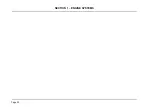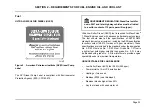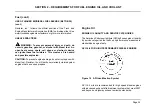
SECTION 1 – ENGINE SYSTEMS
Engine Description (cont.)
The camshaft is supported by five bushings pressed into the
crankcase. The camshaft is crankshaft driven, and thrust is
controlled by a plate mounted behind the rear bulkhead.
An open crankcase breather system draws crankcase vapors
through a breather element. The breather element separates
oil from oil vapors, then routes breather air through an open
breather outlet tube assembly and returns the oil to the
crankcase through a passage in the right valve cover.
Crankshaft
The crankshaft is supported by five main bearings with fore and
aft thrust controlled at the upper half of the fourth main bearing.
Two connecting rods are attached to each crankshaft rod journal
and are offset to minimize vibration. Piston pins are free floating,
allowing the pins free lateral movement within the connecting rod
as well as the piston. Piston pins are held in place with retaining
rings.
Cylinder Heads
The cylinder heads have four valves per cylinder. Each fuel
injector is centrally located between the four valves and directs
fuel over the piston bowl for improved performance and reduced
emissions.
The overhead valve train includes hydraulic roller cam followers,
push rods, rocker arms, and valve bridges to open the dual
intake and exhaust valves.
Electronic Control System
An Engine Control Module (ECM) monitors and controls engine
performance to ensure maximum performance and compliance
with EPA emissions requirements.
Heavy-Duty On-Board Diagnostics (HD-OBD) is a U.S.
Government mandated standard for all 2013 and later Class 4
and above vehicles with a Gross Vehicle Weight Rating (GVWR)
of 14,001 pounds or more. The HD-OBD system monitors the
engine and aftertreatment systems to verify they are operating
within emissions limits.
If an emissions fault is logged, the
Malfunction Indicator Lamp (MIL) will illuminate and one or more
fault codes will be set.
The HD-OBD system operates similarly to previous power train
control systems by storing fault codes and turning on the MIL. If
the problem that caused the fault goes away, the code will clear
and the MIL will go out after certain operating conditions have
been met. This may take several times operating the vehicle.
The Crankshaft Position (CKP) sensor and the Camshaft
Position (CMP) sensor are used by the ECM to calculate rpm,
fuel timing, fuel quantity, and duration of fuel injection.
Fuel System
The high-pressure fuel system includes a High-Pressure Fuel
Pump (HPFP), high-pressure common rails, and fuel injectors.
The ECM electronically controls the injectors, allowing multiple
Page 20
Summary of Contents for MaxxForce 7
Page 8: ......
Page 10: ...FOREWORD Page 2...
Page 14: ...SAFETY INFORMATION Page 6...
Page 22: ...WARRANTY Page 14...
Page 40: ...SECTION 1 ENGINE SYSTEMS Page 32...
Page 56: ...SECTION 3 INSTRUMENTS INDICATORS AND SWITCHES Page 48...
















































